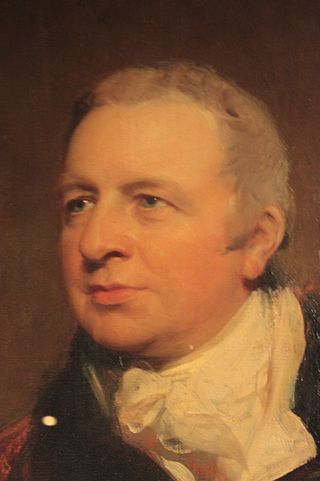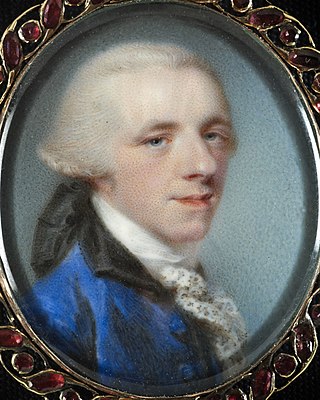
Richard Porson was an English classical scholar. He was the discoverer of Porson's Law. The Greek typeface Porson was based on his handwriting.

John Julius Angerstein was a London businessman and Lloyd's underwriter, a patron of the fine arts and a collector. It was the prospect that his collection of paintings was about to be sold by his estate in 1824 that suddenly galvanised the King, George IV, and the prime minister, Lord Liverpool, into purchasing his collection for the nation and led to the founding of the British National Gallery in Angerstein's house at 100 Pall Mall.

The East India Company College, or East India College, was an educational establishment situated at Hailey, Hertfordshire, nineteen miles north of London, founded in 1806 to train "writers" (administrators) for the East India Company (EIC). It provided general and vocational education for young gentlemen of sixteen to eighteen years old, who were nominated by the Company's directors to writerships in its overseas civil service. The college's counterpart for the training of officers for the company's Presidency armies was Addiscombe Military Seminary, Surrey.

George Birkbeck FRS was a British physician, academic, philanthropist, pioneer in adult education and a professor of natural philosophy at the Andersonian Institute. He is the founder of Birkbeck, University of London and was head of the Chemical Society. He is one of the creators of the earliest chemistry laboratory for undergraduates at University College London, and is also known for the creation of mechanics' institutes in Scotland and London.

Sir Francis Baring, 1st Baronet was an English merchant banker, a member of the Baring family, later becoming the first of the Baring baronets.

Sir Hugh Myddelton, 1st Baronet was a Welsh clothmaker, entrepreneur, mine-owner, goldsmith, banker and self-taught engineer. The spelling of his name is inconsistently reproduced, but Myddelton appears to be the earliest, and most consistently used in place names associated with him.

Sir John Lubbock, 1st Baronet was an eminent English banker. Lubbock was also a merchant and Member of Parliament. He was the first son of a Cambridge don, the Reverend William Lubbock of Lammas, Norfolk, by Elizabeth, daughter of Thomas Cooper of North Walsham, Norfolk. He married Elizabeth Christiana Commerell, daughter of his business partner, Frederick Commerell of Hanwell, Middlesex and his wife Catherine Elton on 12 Oct 1771 at St Dunstan's in the East, London. They had no children. In 1806 he was created a baronet, of Lammas, with remainder to his nephew John William Lubbock, who succeeded him as second baronet.

George Hibbert was an English merchant, politician, slave-owner, ship-owner, amateur botanist and book collector. With Robert Milligan, he was also one of the principals of the West India Dock Company which instigated the construction of the West India Docks on London's Isle of Dogs in 1800. He also helped found the Royal National Lifeboat Institution in 1824.
Richard Muilman Trench Chiswell was an English banker, antiquarian and MP. He committed suicide after his bankruptcy.
Richard Sharp, FRS, FSA, also known as "Conversation" Sharp, was an English hat-maker, banker, merchant, poet, critic, Member of Parliament, and conversationalist. He was at various times known in London society as "Hatter Sharp", "Furrier Sharp", "Copenhagen Sharp", or most famously of all as "Conversation Sharp".

The Oriental Club in London is an exclusive Private Members’ Club established in 1824 Charles Graves describes it as fine in quality as White's but with the space of infinitely larger clubs. It is located in Stratford Place, near Oxford Street and Bond Street.

The King of Clubs was a famous Whig conversation club, founded in 1798. In contrast to its mainly Tory forerunner The Club, it was a predominantly Whig fraternity of some of the most brilliant minds of the day. The club met at the Crown and Anchor on Arundel Street off the Strand, in London.

Sir Richard Neave, 1st Baronet was a British merchant and a Governor of the Bank of England.
Sir Thomas Baring, 2nd Baronet, was a British banker and Member of Parliament.
James Savage (1767–1845) was an English antiquary, who worked as printer, bookseller, librarian and newspaper editor.

Richard Thomson (1794–1865) was an English librarian and antiquary.

The City of London Tavern or London Tavern was a notable meeting place in London during the 18th and 19th centuries. A place of business where people gathered to drink alcoholic beverages and be served food, the tavern was situated in Bishopsgate in the City of London. The original tavern was destroyed in a fire on 7 November 1765 and the new building was designed by William Jupp the elder and opened in September 1768. In 1828, the proprietor was Charles Bleaden. The building was demolished in 1876. The tavern boasted a large and well-decorated dining room with Corinthian columns. It hosted numerous public and private meetings held to rally support to various political, charitable and other causes.

Richard Puller (1747–1826) was a prominent English merchant banker in London. He has sometimes been identified as the pseudonymous economic writer Piercy Ravenstone, considered a precursor of Karl Marx; but scholarly sources generally now follow the suggestion of Piero Sraffa that Ravenstone was Richard Puller the younger (1789–1831), his son.
William Maltby (1763–1854) was an English solicitor, librarian and bibliographer, known also as a close friend of the poet Samuel Rogers.














